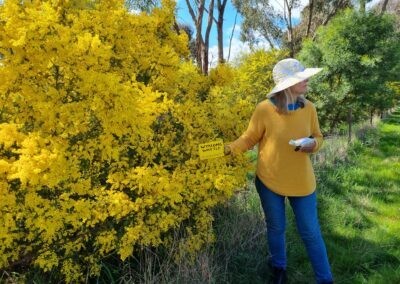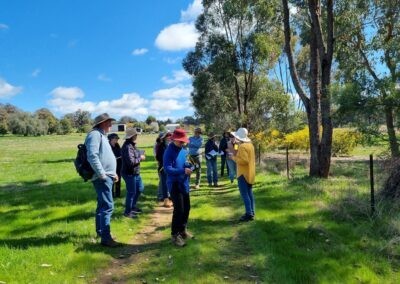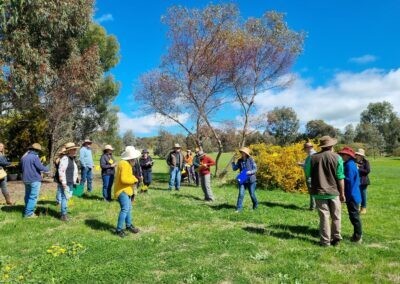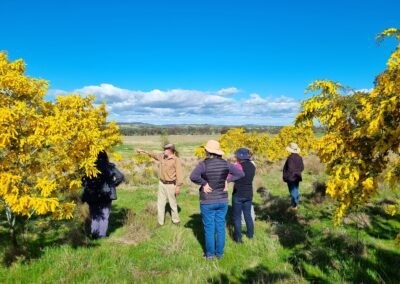Weddin Landcare recently celebrated National Wattle Day, which is held on 1 September, by holding a Wattle Day Walk at Mikla Lewis and Wayne Lavers’ property “Rosemont” near Grenfell.
“We had a really good roll-up of over 20 people for Wattle Day, with many new faces among the attendees” reported Melanie Cooper, Local Landcare Coordinator and organiser of the event.
“Mikla and Wayne have such a vast array of wattle species on their property and many of them are at their peak flowering at the moment. With the sun out, it was a perfect chance for visitors to witness the brilliance of the wattles on ‘Rosemont’” she added.
Mikla Lewis and Wayne Lavers have transformed their property over the past 20 years from bare cropping paddocks to productive pastures filled and surround by native plantings that have created an incredible ecosystem that attracts wildlife and supports livestock grazing. They are currently taking part in the Carbon Plus Biodiversity Pilot program being run by the Department of Climate Change, Energy, the Environment and Water, which is testing the concept of buying and selling biodiversity services. As part of this, Mikla and Wayne have recently completed around 32km of direct seeding to revegetate whole paddocks with native plants, including many local species of wattles.
“It is fantastic to see how Mikla and Wayne have utilised the incredible properties of wattles to improve biodiversity, livestock production and carbon sequestration on their farm” said Melanie.
“Wattles are not only aesthetically pleasing – they play incredibly important roles in ecosystems and on farms and have many uses for humankind”
“Wattles are colonisers of bare ground, are fasting growing and can quickly repair soil and prepare it for the next plant to succeed. Many people dislike wattles because of the stigma that they don’t live for long. But this is their role. They are a legume so they fix nitrogen and create the soil conditions for other plants to germinate and thrive.
They are also prolific seeders and can sucker so even if some species don’t live very long, they readily regenerate.
There are also some long lived species of wattle such as Weeping Myall, which can live for over 200 years.
Wattles, like other legumes, are also particularly good at sequestering carbon because they have an abundance of Nitrogen that helps them to efficiently use Carbon from the atmosphere. They are well adapted to our local environment and are drought hardy, which makes them the perfect choice for planting on farms.
Livestock can also benefit from wattles through shade, shelter and foraging. Wattle leaves and pods can be browsed and are quite high in protein. The plants benefit from light grazing, provided they are mature enough. The tannins in wattle have also been known to act as a worming agent for livestock.
Aside from all these great benefits, wattles are also incredibly important to our native wildlife, with many species heavily dependent on them as habitat. By planting wattles we can lift the biodiversity on farms, which has positive flow-on effects to other aspects of the farm and the health of whole landscape” said Melanie.
Attendees at the Wattle Day event received an informative talk from Mikla then sampled some wattle-seed inspired treats for morning tea before heading off to learn about the different species and plantings on the property. After lunch, Wayne took keen participants for a drive to the back of the property, where whole paddocks have been conserved for biodiversity, with wattles a prominent feature.
Everyone also received some wattle plants propagated by the Weddin Community Native Nursery, which specialises in growing local native plants. The Nursery is currently taking large orders for 2024 and can be contacted on 0456 879 481 or email weddincnn@outlook.com.
“Our Wattle Day Walk is always popular and each year we try to incorporate something different. It has been incredible watching the changes that have occurred to ‘Rosemont’ over the years and seeing the list of birds and other animals grow. We can’t wait to see what will happen once the direct seeded paddocks start to grow” said Melanie.




